Posts Tagged DK Landscaping
How to Transplant Shrubs in Summer
The best times of year to transplant trees and shrubs are spring and fall; however, certain situations may make it necessary to move your plants outside of those seasons. For example, you may want to take your shrubs with you if you are moving or you may have to move the plant because of the weather.

If you find it necessary to move a plant during the warmest part of the year, you will need to take certain steps to ensure its health. Here are some tips on how to move shrubs in the summer without harming them:
- Choose the Right Location
Transplantation represents a dramatic change and a plant will have to adapt to its new environment slowly in order to survive. This means that you will have to keep factors like sunlight, soil drainage and soil pH in mind when choosing a new location. - Dig an Appropriate Hole
You will need to dig a hole that is approximately twice as large as the shrub’s root system. The additional space allows the roots to grow into the new site comfortably. - Carefully Remove the Shrub
Work carefully to avoid damaging the root system when uprooting shrubs. You will want to take as much of it as you can. You will also want to move some of the soil from the old location to the new one. You can place larger shrubs on a tarp and drag them to the new location along with some of the soil. - Add Adequate Water to the New Hole
You will want to wet the hole thoroughly before placing the shrub into it but avoid oversaturating it as this can cause the shrub’s roots to rot. - Place Shrub in the New Hole
Along with the shrub, place some of the soil from the old location into the hole as well as some potting soil. Pat the soil down around the base to ensure that the shrub stays upright. You can add watering stakes to the ground so that the shrub can water at root level but this is not essential. Be careful to avoid damage to the roots when installing the watering stakes.
The quality of your landscaping plays a major role in your ability to enjoy your yard and in your property value. If you need help with moving shrubs or with any other aspect of landscape maintenance, contact us today. Our experienced landscaping crews know how to move your shrubs and trees quickly and without damaging them.
Plant Trees and Shrubs That Add Interest to a Garden in Winter
Tons of homeowners run down to their local nursery to pick up shrubs and small trees for their garden design. You can actually find some great deals by purchasing cold-hardy plants, shrubs and trees out of season, so to speak, prior to the thermometer dropping in September and October.
The problem is that these same homeowners don’t exactly know what to do with their cold-hardy plants and shrubs or whether they can set to work planting them in late fall and early winter or if they have to wait until the weather warms up in spring to put on their gardener’s hat.
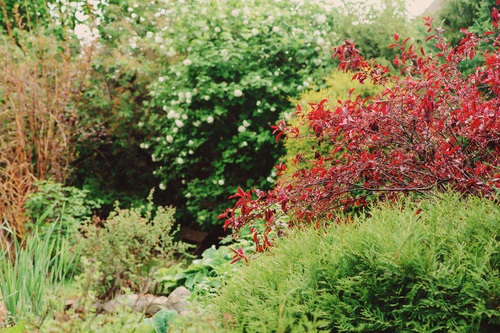
How to Deal with Cold-Hardy Trees, Plants and Shrubs
What you may not know is that a variety of shrubs, plants, perennials, and trees can survive and even thrive in – what the USDA terms – the coldest planting zones in the country.
So, the question no doubt on the minds of everyone in these more frigid hardiness zones is whether to keep your trees and shrubs in pots throughout the cooler months or whether you can get started in late fall.
The answer’s that you can choose to do either, but you can definitely set to work right now, start planting in the late fall, and beautify your garden and outdoor decor throughout the winter and into the verdant spring months. Evergreen shrubs and hawthorn are two popular options.
What you still want to do, though, is manage your expectations and perhaps set your sights lower than a veritable Garden of Eden springing up in the crisp winter months. Here’s how to get started:
- Follow Nature’s Lead
You would be very hard-pressed to find potted plants, much less artificial ones, growing wild out in nature.
Taken that to its logical extension, your plants and shrubs will typically be healthier and happier by being put into the ground than staying in a plastic pot in your garage throughout the winter season.
- What Should I Plant?
Evergreen garden shrubs are but one example of resilient shrubs that can really add another dimension to your garden and front lawn during the winter without causing too much heartache in terms of worry or added energy you have to expend to make it happen.
Both conifer trees and evergreen shrubs can make it through winter in one piece, and the needle-leaf style of evergreen shrubs are normally considered more robust in cold-hardy climates.
Yew and Juniper are two kinds of evergreen garden shrubs that are resilient, tolerant to cold temperatures and drought conditions, yet really benefit from developing their root networks early in the fall (if you’re thinking about planting these early) as opposed to waiting until early-to-mid spring.
Deciduous trees like the Japanese Maple, eucalyptus, birch or hawthorn tree can even demonstrate fruit growth in the winter, which really adds a splash of color and interesting contrast against the icicles and powdery, white winter snow.
- Going About It the Right Way
Year-round plants, shrubs and trees don’t actually need the extra shot in the arm that less hardy flora might.
There’s no need to use a crazy amount of fertilizer or growth agents in the late fall to get the most out of these trees and shrubs throughout the winter.
Still, realize that many of these flora grow upwards and their root networks are delicate at this early stage. Try not to move around or prune these shrubs early in their development.
Much and a little water in the fall are probably all these plants need to avoid desiccation and thrive for you year-round. Contact us today for more tips or help in getting started.
Xeriscape California Plant List
California boasts a rich variety of flowers, trees, and flora ~ a somewhat surprising fact considering the prevalence of arid landscapes and drought. Home and business owners who want an eco-friendly, economic landscaping solution would be wise to utilize xeriscape, a form of landscaping that combines drought-resistant plants, efficient irrigation, and thoughtful garden design to create beautiful outdoor spaces. To get started, check out this list of plants that will make a wonderful addition to your xeriscaping.

Aloe
Aloes are a variety of succulents that do well in dry environments. One common variety is Aloe Vera, also known as burn plant due to its ability to soothe sunburn. Aloe Vera can grow up to 3 feet in height and produces lovely yellow flowers. Although commonly grown as houseplants, Aloes can also thrive in xeriscape environments due to their preference for bright light and dry, well-draining soil.
Agave
This xeriscape-friendly plant is known for its use in making tequila! There are many different varieties, but all have a main taproot that discourages transplanting after they have been installed. A loose, well-draining soil is a must and plants prefer to dry out completely between watering. Agave tends to bloom once, then die, but often produces pups, or baby plants, that can replace the original.
Mexican Sage
A member of the Salvia family, Mexican Sage is a perennial that produces gorgeous purple or white flowers that can make it a stunning xeriscape addition. Moisture requirements are somewhat higher than for previously mentioned succulent varieties, so it may not be ideal for very arid locations. However, it is drought tolerant and often attracts pollinators like butterflies and hummingbirds.
Verbena
Verbena comes in many varieties, including lemon, rose, and purpletop, just to name a few. Lemon verbena smells fantastic and can be used to make herbal tea. They can be grown as annuals or perennials and are resistant to heat and drought. Depending on the variety you choose, they can get quite tall and bushy, often producing beautiful, brightly colored flowers.
Honeysuckle
Most honeysuckle vine varieties smell fantastic, attract pollinators, produce beautiful flowers, and come back year-after-year. Being heat and drought resistant and fairly low maintenance makes them a wonderful addition to xeriscape areas. Full to partial sun and a well-draining soil are preferable. A fence, trellis, or other support system helps them grow to their full potential.
Sedge Grass
Sedges are a large family of grasses that work well in place of more high maintenance turf grass. They tend to be adaptable and often require little water. California meadow sedge is native to the Pacific coast area and tolerates heat, drought, and even foot traffic. It can be used as part of an eye-catching xeriscape focal point or used to replace a more traditional lawn. Since it requires very little mowing and no fertilizers or other chemicals, sedge grass is a great, no-fuss addition to any landscape.
Hollyleaf Cherry
The hollyleaf cherry tree is a shrub native to the California coast that produces lush, evergreen leaves, cream colored flowers, and edible fruit. The fruit is not very fleshy though, so it probably won’t become your favorite snack, but birds and other wildlife may appreciate it. Hollyleaf cherry is very tolerant of drought, thrives in full to partial sun, and prefers well-draining soil.
Xeriscape landscaping techniques are sure to become more popular as awareness grows about the need to conserve water and choose drought resistant plants. DK Landscaping strives to create beautiful landscapes that function well in the natural environment, so call us or contact us via email today to get started on a xeriscape project for your home or business.
Plant Maintenance : Sprinkler Systems, Irrigation Controllers
A home plant maintenance system might just be the most worthwhile outdoor home improvement project going today. An automated sprinkler system – brought under your control with an irrigation controller – beautifies your entire lawn and garden and makes having guests over a pleasure instead of something to fret over.
Irrigation systems are designed to efficiently deliver water straight to your roots without squandering water and overwatering, which can cause its own set of problems. You really want to avoid overwatering since waterlogged soil precludes your roots from absorbing oxygen and really flourishing.

How Homeowners Benefit By Automating Their Irrigation
Without a home automated sprinkler system or drip irrigation system loaded with sensors and brought under your control with an irrigation controller, it can be difficult to determine what exactly the right amount of water for your lawn and garden.
An automated system with controllers and sensors, in short, allows you to have greater peace of mind and save potentially hundreds of hours every year on watering and manual maintenance that could otherwise be automated and strictly measured with Smart controllers and sensors.
- Irrigation Controllers For Your Home
Automated sprinkler systems outfitted with an irrigation controller and sensors to detect soil, water and weather conditions greatly benefit homeowners and business owners alike. You may have heard irrigation controllers called “irrigation timers,” and that’s because these controllers can kickstart your automated sprinkler system at just the right time, every time.
An irrigation controller works with automated sprinkler systems as well as more traditional drip irrigation systems.
The reason homeowners are increasingly choosing to use irrigation controllers in their lawns and gardens is because they want to have the autonomy to set the exact starting time of watering cycles and alter the frequency and duration of daily irrigation based around their needs and changing seasons.
Every home is different and has different irrigation needs: You may have a home in an arid area that needs longer and more frequent home irrigation or a home in a temperate climate that gets plenty of rain and sunshine.
You might also have a larger lawn or garden with flowers, plants, and vegetables that would do well with a little bit of water throughout the day. Irrigation controllers let you have that control and deliver just the right amount of nourishment that your home, lawn and garden need.
- Get It Just Right With Sensors Too
Imagine this scenario: You have your automated home sprinkler system installed, you’re feeling good about your lawn, garden and the shrubs in front of your home, and you even have an irrigation controller setup that allows you to control the duration, time and frequency of your daily watering regimen.
Things are looking good…but can you improve things further? Can you virtually eliminate the possibility of overwatering?
The answer’s yes you can: automated sprinkler systems that use both sensors and irrigation controllers allow you the most control. How? Irrigation controllers essentially set the basic framework that you and your landscape maintenance company have determined is the best for your home’s or workplace’s lawn.
Controllers then fine-tune the process by giving your real-time rain and weather information that can tell your automated system to deliver more water (e.g., in drought-like conditions) or less water when your lawn is in danger of being overwatered. As we discussed above, overwatering can be just as detrimental as underwatering.
An automated sprinkler system or drip irrigation system with an irrigation control and sensors gives you more options, virtually eliminates the chances of over/underwatering, and allows you to efficiently bring the best out of your lawn, garden, home and workplace. Contact us for more lawn care tips.
How Irrigation Can Improve Your Lawn, Garden and Curb Appeal
The reasons that homeowners and businesses have irrigation systems installed are easy to understand. They’re trying to eke out more bang for their buck by going with irrigation advancements like micro irrigation, drip irrigation and spray tanks.
Irrigation is simply the best way to ensure that your home garden and lawn care needs are being met without having to worry about underwatering or overwatering.
Because irrigation and home sprinkler systems can be automated, you don’t need to fuss about achieving the best results possible.
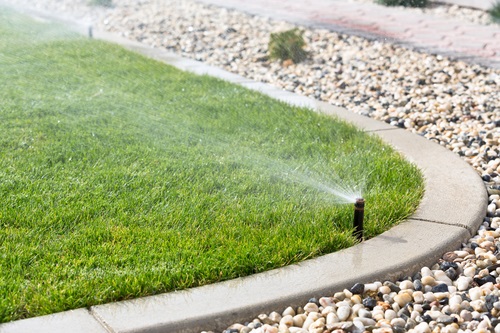
Irrigation Benefits Your Entire Property
You can even automate your system to behave differently in your garden versus your lawn, and you can also change up your watering cycles based on seasonal changes or plant growth.
Drip irrigation systems can also be extended to reach places that are just growing in or ones that didn’t exist when you originally installed the system. In terms of modifiability and adaptability to changing conditions, that’s pretty much the gold standard.
Especially when you’re dealing with a larger lawn in an arid region or a larger commercial property that needs virtually around-the-clock attention, an automated sprinkler system coupled perhaps with a drip irrigation setup can actually save you money long term. Homes benefit and conserving water, money and manpower is what it’s all about.
- Save Water, Conserve Manpower, Increase Curb Appeal
Drip irrigation is especially advantageous to homeowners and businesses in arid regions of the country that seasonally experience droughts, water shortages and steeper water prices (e.g., states like California).
The way that drip irrigation works – allowing water to drip down to different plants and root zones via pipes, emitters and valves – can consistently deliver more water to the roots and increase yields….all while saving water.
At the same time that you’re saving 50% more water compared to regular sprinkler systems, you’re getting better coverage and you’ll naturally experience less weed growth.
All of this together could very well bolster your curb appeal or, if you’re running a business, bring in more customers: A professional first impression goes a long way.
Incorporating Irrigation Into Your Lawn Care Routine
Business owners reading this might be scratching their chins and wondering whether they really need an irrigation system or if they can get by with simply watering twice a week. First off, you should realize that simply watering might not be enough.
If you’re running a commercial property, then irrigation is but one piece of the puzzle when it comes to maintaining a professional image. Mowing, mulching, fertilization, aeration and leaf removal might all be part of the overall picture in terms of getting the most out of your property or maximizing the curb appeal of your home.
That said, irrigation is one of those foundational lawn care services that really gets at the heart of landscaping. Why? Because irrigation delivers water right to the root source and if plants, trees and lawns don’t have enough water and sunlight they’ll definitely under-perform.
- Easy (and Expandable) Installation
While soaker hoses and sprinkler hoses might be the easiest-to-install and most DIY form of drip irrigation around, even professionally installed drip irrigation systems are relatively simple to install and shouldn’t require any excavation at all.
Because residential and commercial irrigation systems frequently rely on tubing, you can work with a landscape maintenance company to home in on the best location for the system. You can even move the system around if your needs change or power up/down the system to fit seasonal changes.
Drip irrigation systems efficiently deliver water right to the root source and are ideal for cost-efficiently achieving the best lawn possible. Consult with us on how you can benefit.
6 Xeriscape Ideas
Xeriscape gardens are specially built to require little to no irrigation. Instead, they’re specially constructed to use minimal water, and conserve the natural water (like rainwater) that enters their system. The end result is an environmentally-friendly garden that’s still beautiful.
Because xeriscape involves such skill and knowledge, it can be tricky to know where to get started. But with these six xeriscape ideas, you’ll get a head start on planning your garden.
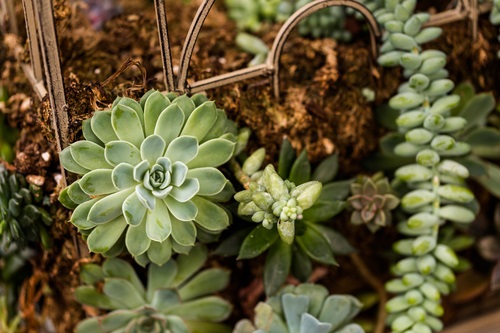
1. Think Beyond Cactus
Many people think xeriscape gardens are restricted to cactus and succulents. But most local plants are resistant to dry conditions in your area. Research native plants, or inquire with local gardening organizations, to find out what plants would flourish in your xeriscape garden.
2. Use Drip Irrigation
While many xeriscape gardens use no irrigation whatsoever, some use a form of irrigation called drip irrigation. Put small holes in a garden hose (or buy a hose specially perforated for this purpose), then lay it flat against the ground or near to it. Run this hose in the early morning or late evening, to minimize water loss due to heat.
The vast majority of the water through this slow drip system will get soaked up through the earth where it can nurture your plants, rather than getting lost to spray or evaporation. This is a good way to keep even drought-resistant plants through dangerous droughts, or to encourage your blooms to look their fullest during a dry season. To further maximize this method’s potential, place any plants that need more water close together, so they’re easier to water.
3. Try Perennials
Perennial flowers are more likely to be drought-resistant than annuals, and they’re lower maintenance, too. Try planting a group of perennial blooms close together to maximize their visual impact. For additional beauty, choose several perennials that will bloom at different times of year and plant them throughout your garden, to make sure you’ll always have something blooming.
4. Plan for Fall and Winter
Plants like Russian sage and many ornamental grasses dry out in the colder months. This is actually a positive: a well-planted standing will look like a dried bouquet. Add these to your xeriscape garden so there’s always something to draw the eye, no matter the season. You may even choose to avoid cutting back plants in colder months, to better take advantage of dried plants’ unusual shapes and appearances.
5. Fill Space with Rocks
Many xeriscape gardens gravitate toward gravel for open spaces. Gravel is great because it isn’t water-hungry like grass, and it holds moisture better than soil. But adding some beautiful rocks to cover space is a way to add texture and color to an area. Even just a small portion of rock garden adds character and variety to your xeriscape garden.
6. Play with Style
Not every xeriscape garden needs to look like a desert. With a little creativity and planning, xeriscape adapts well to any aesthetic or garden style. Don’t be afraid to think outside the box.
Xeriscape isn’t just environmentally friendly: it encourages creativity by imposing limits and forcing gardeners to think outside of comfortable tropes. Contact us and let us, plan and think creatively together. You’ll create a water-efficient space that’ll look its best in any season.
Use a Weed Eater and Get Rid of Pesky Shrubbery
If your property is saddled with unsightly shrubs that just keep getting in the way of the rest of your landscaping or even your walkways, the solution is our weed eater service. Shrubbery has a tendency to overgrow in every which way, causing all sorts of havoc. This is a common problem that can be cleared up by our weed maintenance team.
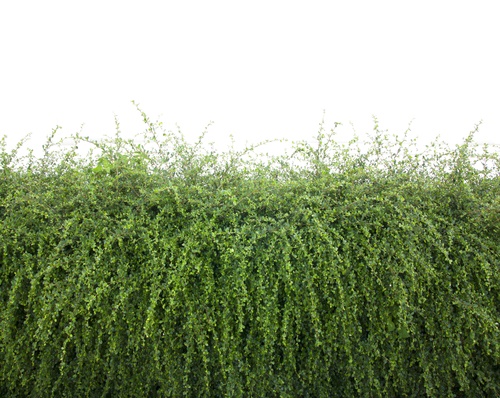
Do Yourself a Favor and Ally With the Weed Control Experts
Unruly shrubbery has the potential to ruin an otherwise beautiful yard. The weed control aficionados here at DK Landscaping know all the nuances about weed control products and weed control strategies. We will prevent wayward shrubs and weeds from overflowing onto surrounding components of your landscape. If you have any questions as to what the best way is to manage those pesky shrubs, do not hesitate to reach out to our experts. We know the ins and outs of weed control products as well as weed eating machines. Allying with our team has the potential to save you plenty of time, money and heartache.
Don’t Torture Yourself Attempting to Manage Shrubs by Hand
DK Landscaping has all the equipment that is necessary to get rid of those unruly shrubs once and for all. Too many homeowners make the mistake of trying to manage shrubs and weeds by hand. This is a waste of time and effort. You can trust our team to use our state of the art weed eaters to put an end to your shrub problem. It is a quite an easy solution compared to attempting to find a product that will keep those shrubs under control or using your hands to remedy the issue.
Our Weed Eater Equipment
DK Landscaping refuses to use anything but the highest quality metal blade edgers to trim shrubs and other aspects of customer lawns. This style of cut allows for superior precision and control to generate the cleanest possible cut. It is a stark contrast from our competitors who use string edgers that create wavy edges and ugly wide gaps. Such wavy edges and gaps look terrible and allow for conditions in which weeds and shrubs grow in all directions. You can rely on our shrubbery and weed experts to use our weed eaters with great care. Our team is well aware of the fact that these powerful machines move at speeds topping 4,000 revolutions per minute.
Shrub Beds are Quite Sensitive
There is absolutely no point in attempting a do it yourself (DIY) style shrub maintenance job in which you pluck shrubs/weeds out of the ground. Hand weeding actually leaves the roots intact so those annoying weeds and shrubs will keep on growing right back. Furthermore, using a low quality weed fabric will allow weeds to break through. Even attempting a DIY mulch job has the potential to exacerbate your shrub and weed problem. If you do not select the proper type of mulch, it will affect the soil’s warmth and consequently impact the growth rate of your shrubs.
DK Landscaping is Here to Help
You are not alone in your battle with these disorderly shrubs. When you ally with DK Landscaping to eliminate those pesky shrubs, you will no longer feel disappointed and annoyed when you look at your property’s landscaping. Our weed eaters will get right down to the core of the problem so you don’t have to invest one more second in shrub management. Reach out to DK Landscaping today to schedule a consultation and/or an appointment. We’ll discuss our services in-depth with you and provide a quote. Contact us today by dialing 707-280-3632.
About Watering Lawn After Mowing
Engaging in watering lawn? As the weather heats up, more people will be venturing out into their yards to mow, plant, trim, and generally get things spruced up. Mowing the lawn becomes an almost constant chore from the time the dandelions pop up in the spring until the leaves fall in the autumn. Whether you choose to mow your own lawn or hire experienced professionals, you may have some questions about watering your lawn after mowing.
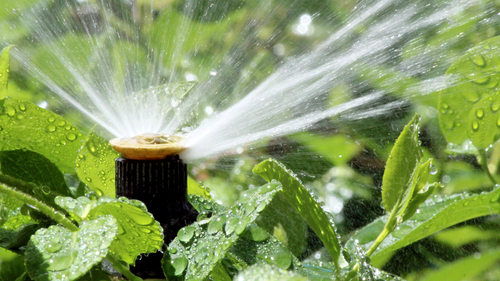
Setting a Schedule for Mowing
While mowing and watering are two separate chores which should both be scheduled, it’s important to leave room for flexibility for the days of drought and when it pours. The lawn needs mowing when the grass reaches a certain height and watering when the grass is dry. Those two events may or may not occur at the same time. Establishing a schedule to address these needs will help you make sure you aren’t wasting water or time. You should mow when grass reaches a height of about 3 to 4.5 inches. When it’s tall enough, trim it to about 2 to 3 inches. Depending on the season and type of grass, you may need to schedule mowing as often as every 5 days.
Setting a Schedule for Watering
Schedule your watering so that grass gets about 1.5 inches of water per week during the growing season. Time of day is also important to consider. Morning is an ideal time to water because it allows the grass to soak up the water before the heat of the day. Watering in the middle of the day wastes water because the sun speeds evaporation. In addition, watering too late in the day leaves insufficient time for the water to soak in before it cools off at night, potentially leading to fungal growth or other disease.
Knowing When to Water by the Color of Your Grass
Determining that grass needs water is a little tricky, but there are some things to look for. Grass that fades from bright green to a dull, bluish gray is probably thirsty. Also, look for signs of wilting, such as curling grass blades. Another trick is to look for footprints in the grass after you’ve been walking in the yard. Hydrated grass will spring back more than dried grass so, if you can see that you’ve left a trail, it’s time to water. One foolproof way to know if your grass needs a drink is to use a simple moisture meter, available at many garden stores. Or, utilize a rain gauge so that you know how much natural precipitation has fallen during the week.
A Pristine Lawn Takes Time and Attention
So, should you water after mowing? The simple answer is yes, but only if your grass needs the moisture. If you’ve had a rainy week and the grass isn’t showing footprints or other signs of dehydration, you can probably put off watering for a bit longer. If your lawn does need to be mowed and watered, make sure you schedule it for early in the day to avoid moisture evaporation and problems with disease. Don’t water your grass before mowing. Wet grass tends to clump together on the lawn which could suffocate the grass underneath or promote fungal growth. Also, it could clog up your mower.
Mowing is an essential aspect of home maintenance. A freshly-mowed lawn looks great, feels wonderful on bare feet, and helps keep invasive weeds in control. To handle all of your mowing needs, get in touch with the professionals at DK Landscaping today. You can trust us to keep your yard looking great for all seasons.
Narrow Walkway Flower Bed Ideas
Flower bed ideas can be quite easy to implement. Most gardens have walkways that are about two feet wide. Narrower walkways may help you to use a small space more efficiently.
However, they pose a unique design challenge to gardeners, landscapers and homeowners: how can you create and position flower beds so that they don’t visually overpower the walkways? Try these flower bed ideas to add variety and beauty to your space.

Perennial and Evergreen Flower Bed Ideas
Narrow walkways limit access to your flower beds, and make maneuvering through the space more difficult. Annual plants are flower bed ideas that can create headaches due to yearly replanting. By choosing perennials suitable to your climate, you’ll ensure that your plants come back each year and minimize the amount of work you (or your landscapers) must do.
You may also put evergreen plants on your list of flower bed ideas. These come back each year, and the plants won’t lose their leaves or fade in ways that require additional maintenance.
Keep Flower Beds Controlled
If your flower beds grow weedy or otherwise out of control, they can cut into your walkway. Normally that may be unsightly, but not a disaster. But if your garden’s walkways are narrow, this can make the pathway difficult to navigate, or even find. This is particularly problematic with gravel or dirt walkways, where the edges are already, often, poorly defined.
When going through your flower bed ideas, make sure that the line between the flower bed and the path is clearly marked. You may want a small fence, stone wall or other raised marker. Make sure your flowers are semi-regularly pruned back from the edges of the path, and that any weeds are removed. You may want to choose plants that grow more slowly, and that put off fewer vines or shoots for you to have to deal with.
Use Trellises
Trellises and fences are perfect flower bed ideas for climbing plants, that allow you more room to play. Be sure to choose climbing plants that don’t grow to too tall of a height, to minimize maintenance. Many vines are invasive, as well, so be sure that your final choice is native to your area.
Create a Unique Environment
Finally, once your flower beds are complete, your garden may feel crowded. Take advantage of this by creating a unique atmosphere. Delicate lighting along the edges of your path, or hanging from trees, can create a mysterious atmosphere like an enchanted forest. A little fence around the whole space, along with a gate, is one of those flower bed ideas that can make your garden feel like something out of a fairy tale.
Conclusion
When you want to implement your flower bed ideas, it’s time to call an expert. Contact us for a consultation about your yard and its specific needs, including repair, maintenance, irritation, and xeriscaping for saving water.
Inexpensive & Easy Backyard Ideas
Spring is just around the corner, and what better time than now to give your backyard a makeover? Whether you have a cozy yard or a sprawling retreat, there are a host of inexpensive and easy backyard ideas you can try that will enhance your lawn, garden and outdoor living areas.
Easy Backyard Ideas
- Create a living fence by decorating a wall with an espaliered tree. You don’t have to be a master gardener to do it, and it gives your yard a high-end look without the high-end expense. Espaliered trees are a great way to make a small yard look like it’s filled with greenery.
- Here’s one of the best money-saving backyard ideas. For an inexpensive way to add hardscaping – walkways, edging and retaining walls – ask your landscaping company if they have stone leftovers. Stacked together, the different shapes, sizes and colors make a beautiful elevated garden section that looks incredibly natural. Use low-growing groundcovers and other perennials to present a gorgeous burst of color.
- Sometimes, the simpler the better backyard ideas win the day. Create low-cost nooks by rearranging garden furniture in separate areas of the yard; perhaps one area for eating and another for relaxing. The idea is to create conversation zones where family and guests can gather to catch up and enjoy themselves. No need to buy new furniture – but coordinated pillows and chair pads are great for giving each area its own distinct look.

- One of the easiest backyard ideas for adding color is by using containers that are filled with annuals. Annuals are less expensive than perennials and shrubs but really pack a punch when arranged in containers. For a calm, retreat-like feel, use vessels of one color, though the shapes and sizes can differ.
- If you’re in need of a new piece of furniture, but it’s just not in the budget this year, try this fun DIY seating area constructed from low-cost concrete blocks that are fitted with wood beams and then a foam cushion. True sophistication for little money!
- Outdoor lights are one of everyone’s favorite backyard ideas. They’re fun, they say celebration and their sparkle adds a warm glow to backyard gatherings. Use different color string lights or LED cords to wrap a tree or line a pathway. You can even run a set down the length of the table for a lovely light to dine by.
- If you want to cut back on how much water-hungry lawn you have, check out interesting, less-expensive paving materials such as crushed rock and gravel. They’re perfect for placing underfoot at outdoor seating and dining areas. If you’re in love with the look of traditional, larger pavers, use fewer of them interspersed in your grass in order to cut down on your total outlay.
- Many hardscape elements, such as trellises, can be found at flea markets or garage sales. You may even have enough scrap materials around the house to construct one. Who doesn’t have a bunch of old frames packed in boxes just waiting to be used “one day?” Take some inspiration from this beautiful piece and put those frames to good use. If you love the rustic look, there’s no need to varnish or paint them. Trellis are one of the best backyard ideas for adding height and defining backyard traffic flow.
There’s always a way to get the beautiful backyard you’ve always wanted without having to break the bank. These fun and beautiful backyard ideas are the perfect way to get started!





